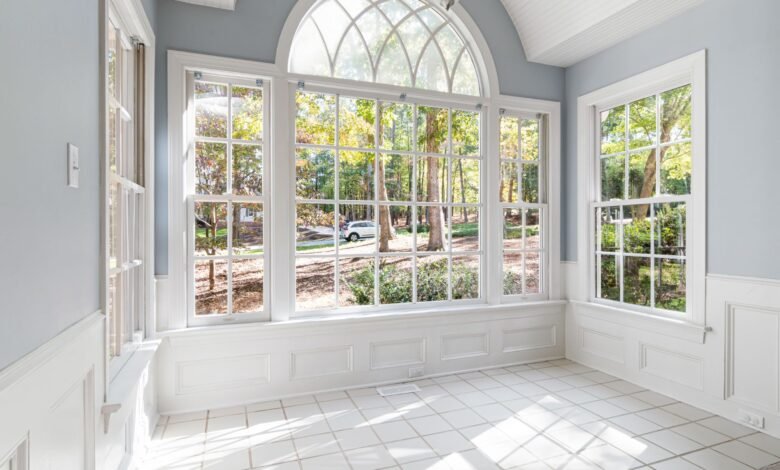How Airtight Windows Reduce Energy Costs and Improve Indoor Air Quality

Airtight windows are more than just a modern feature in energy-efficient homes; they offer a significant impact on both energy savings and indoor air quality. Designed to eliminate drafts, minimize heat loss, and prevent external pollutants from entering, airtight windows can play a pivotal role in creating a comfortable, healthy, and eco-friendly home. This article explores how airtight windows reduce energy costs and improve indoor air quality, along with the key features, benefits, and considerations when installing these windows.
1. The Basics of Airtight Windows: What Sets Them Apart?
Unlike traditional windows, airtight windows are specifically designed to create a sealed barrier between the inside of a building and the outside environment. This design prevents air leakage, one of the main contributors to energy loss and compromised indoor air quality in homes and offices.
Features That Make Airtight Windows Unique
- High-Quality Seals: Airtight windows use durable, high-performance weather stripping and seals that block drafts and reduce air leakage.
- Multiple Glazing Layers: Many airtight windows have double or triple glazing, with layers of glass separated by insulating gases, which slows down heat transfer.
- Advanced Frame Materials: Using materials like vinyl, fiberglass, or treated wood, airtight windows can prevent temperature fluctuations more effectively than traditional windows.
2. How Airtight Windows Reduce Energy Costs
Heating and cooling are responsible for a substantial portion of energy consumption in most homes, and much of this energy is lost through windows. By creating a better-sealed environment, airtight windows reduce the energy needed to maintain a comfortable indoor temperature, translating to considerable savings over time.
Key Ways Airtight Windows Improve Energy Efficiency
- Minimizing Heat Loss in Winter: In colder months, airtight windows prevent warm indoor air from escaping, keeping homes warmer and reducing the need for heating.
- Reducing Heat Gain in Summer: During hot weather, these windows block external heat, reducing the reliance on air conditioning systems.
- Lower Utility Bills: With less energy required to maintain indoor temperatures, airtight windows can lead to lower utility bills year-round, helping homeowners save significantly over time.
- Extended HVAC System Life: Since airtight windows reduce the strain on heating and cooling systems, HVAC units don’t have to work as hard, extending their lifespan and lowering maintenance costs.
Real-Life Energy Savings
According to the U.S. Department of Energy, energy-efficient windows, including airtight models, can reduce heating and cooling costs by as much as 25%. Over several years, these savings can offset the initial cost of airtight windows, making them a financially sound investment.
3. Airtight Windows and Indoor Air Quality: A Healthier Home Environment
Indoor air quality (IAQ) is a growing concern for homeowners, especially for those living in urban areas or with respiratory sensitivities. Airtight windows contribute to healthier indoor air by preventing outdoor pollutants, allergens, and contaminants from entering your home.
How Airtight Windows Improve IAQ
- Blocking Pollutants and Allergens: Airtight windows act as a barrier against pollen, dust, car exhaust, and other airborne contaminants, keeping indoor air cleaner.
- Reducing Mold and Moisture Issues: By reducing condensation, airtight windows help prevent mold and mildew growth, which can exacerbate respiratory conditions.
- Stable Humidity Levels: Airtight windows help to maintain consistent humidity levels, reducing the likelihood of both overly dry and damp indoor environments.
4. Soundproofing Benefits: Creating a Quiet Indoor Space
Airtight windows also contribute to soundproofing, creating a quieter indoor environment by reducing the amount of external noise that enters the home. For those living in noisy neighborhoods or near busy streets, the soundproofing qualities of airtight windows can be a major benefit.
How Airtight Windows Reduce Noise
- Multiple Glazing Layers: Double or triple glazing helps to dampen sound waves, reducing noise from outside.
- Sealed Gaps and Frames: By eliminating gaps, airtight windows prevent sound from passing through cracks, helping to create a more peaceful indoor atmosphere.
- Enhanced Comfort and Relaxation: A quieter home environment can improve quality of life, aiding in better sleep and reduced stress levels.
5. Airtight Windows and Sustainable Living
Sustainability is a key consideration for many homeowners today, and airtight windows align perfectly with environmentally responsible living. By reducing energy consumption and helping lower carbon emissions, airtight windows play an essential role in creating greener homes.
Environmental Impact
- Reduced Carbon Footprint: By reducing energy use, airtight windows help lower a household’s carbon footprint, which benefits the environment.
- Less Strain on Energy Resources: Energy-efficient homes contribute to reduced demand for nonrenewable energy sources, promoting sustainable energy consumption.
- Long-Lasting Materials: The durable construction of airtight windows means fewer replacements and less waste, further adding to their sustainability.
6. Long-Term Financial Benefits of Airtight Windows
While the initial investment in airtight windows can be higher than standard windows, the long-term financial advantages are significant. From reduced energy bills to increased property value, airtight windows offer multiple avenues for financial savings.
Financial Gains from Airtight Windows
- Lower Energy Bills: With airtight windows, homeowners can expect to see reductions in monthly energy bills due to decreased heating and cooling needs.
- Increased Property Value: Energy-efficient features, including airtight windows, are attractive to potential buyers, raising the market value of a home.
- Lower Maintenance Costs: Airtight windows are often more durable and require fewer repairs, translating to lower long-term maintenance costs.
7. Choosing the Right Airtight Windows for Maximum Benefits
To fully reap the benefits of airtight windows, it’s essential to choose the right type for your home. Factors such as the number of glazing layers, frame materials, and energy performance ratings all play a role in how well airtight windows perform.
Considerations When Choosing Airtight Windows
- Glazing Options: Double or triple glazing provides additional insulation, helping to maximize energy efficiency.
- Frame Materials: Vinyl and fiberglass are often preferred for airtight windows due to their durability and high insulating properties.
- Energy Performance Ratings: Look for windows with high energy performance ratings, such as ENERGY STAR certification, to ensure maximum efficiency.
- Installation Quality: Proper installation is crucial for airtight windows to function effectively. Professional installation ensures that windows are sealed correctly and perform as intended.
8. Installation and Maintenance of Airtight Windows
While airtight windows are designed to be low-maintenance, some regular care is necessary to keep them functioning at their best. Routine cleaning, occasional seal checks, and professional inspections can help prolong their lifespan and ensure that they continue to provide energy savings and indoor air quality benefits.
Maintenance Tips for Airtight Windows
- Regular Cleaning: Clean the glass and frames regularly to prevent dirt buildup that could affect the seals.
- Seal Inspections: Inspect the seals for signs of wear or damage annually and replace them as needed to maintain airtightness.
- Professional Inspections: Consider periodic inspections by professionals to ensure that your windows are properly sealed and functioning optimally.
9. Case Studies: Real-Life Examples of Airtight Window Benefits
To understand the impact of airtight windows, let’s look at some real-life examples that illustrate the benefits.
Example 1: Lower Energy Bills in Cold Climates
A family in a cold climate replaced their drafty windows with airtight, triple-glazed windows. Over the first year, they observed a 30% reduction in their heating costs. By preventing heat from escaping, the new windows helped them maintain a consistent indoor temperature without overusing their heating system.
Example 2: Improved Indoor Air Quality in Urban Areas
In a densely populated urban area, an apartment owner with severe allergies installed airtight windows. By blocking out pollutants and allergens from outside, the windows contributed to noticeably cleaner indoor air, significantly improving the occupant’s quality of life.
Example 3: Soundproofing for City Dwellers
A couple living near a busy street replaced their traditional windows with airtight double-glazed windows. In addition to reducing energy bills, the new windows provided a much quieter indoor environment, allowing them to sleep better and enjoy more peaceful evenings.
10. The Future of Airtight Windows and Smart Home Integration
As technology advances, airtight windows are becoming even more sophisticated. New models now integrate with smart home systems, allowing homeowners to monitor and control window settings for optimal energy efficiency and air quality.
Smart Features in Airtight Windows
- Automated Ventilation: Some airtight windows come with built-in sensors that open and close based on indoor air quality, maintaining a fresh environment without compromising airtightness.
- Energy Monitoring: Integrated sensors and apps allow homeowners to track energy savings and optimize their heating and cooling systems based on real-time data.
- Remote Operation: Smart airtight windows can be controlled remotely, allowing users to adjust ventilation from their smartphones or smart home hubs.
Conclusion
Airtight windows are an essential addition to modern, energy-efficient homes. By reducing energy costs, improving indoor air quality, and creating quieter living spaces, they provide a range of benefits that enhance overall comfort and health. With their durability, reduced maintenance needs, and long-term financial gains, airtight windows represent a wise investment for homeowners looking to create sustainable, comfortable, and healthier living environments.
Whether you’re aiming to lower your carbon footprint or simply want a more comfortable and cost-effective home, airtight windows offer a practical solution that delivers both immediate and long-term advantages. As technology continues to advance, we can expect airtight windows to integrate even more seamlessly into the smart homes of the future, making it easier for homeowners to enjoy the benefits of a healthier and more efficient living space.




